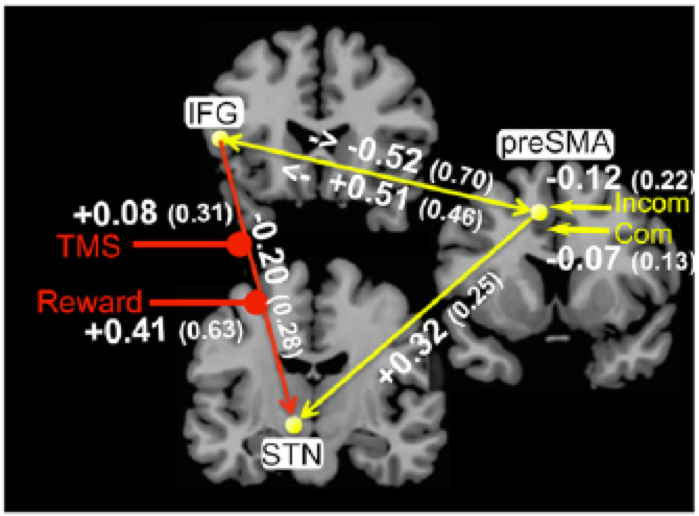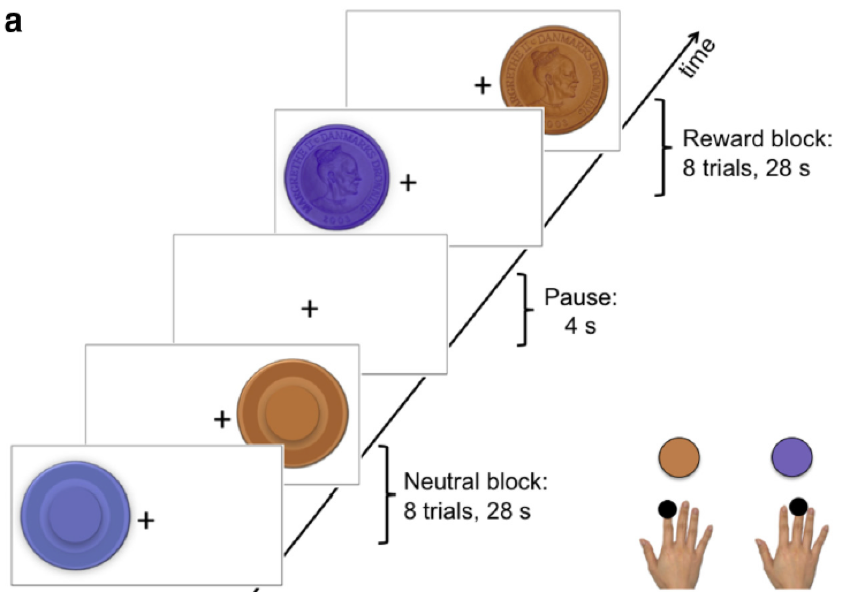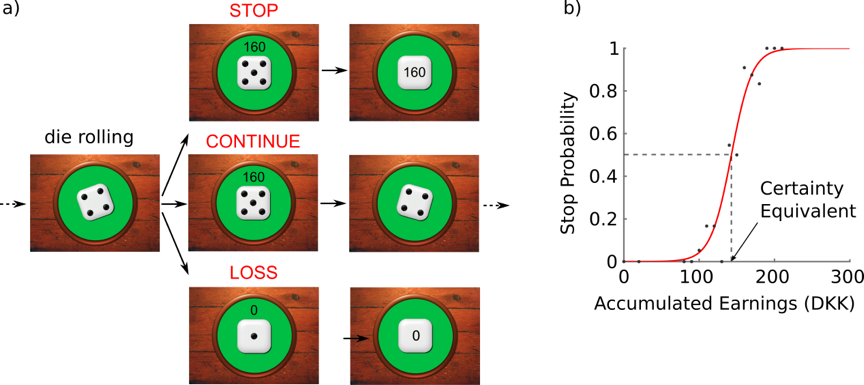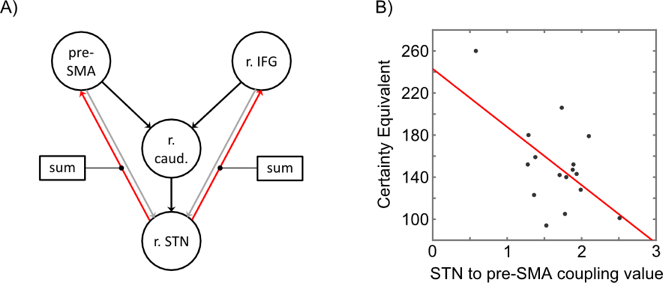Below are two examples of important neural processes in this context that we investaged. Firstly, action control requires the ability to effectively suppress the activation of automatic but inappropriate tendencies to act. Another aspect are changes in subjective preference for different options, requiring dynamic inhibition of one choice in order to switch to another one.
Study 1
Herz DM, Christensen MS, Bruggemann N, Hulme OJ, Ridderinkhof KR, Madsen KH, Siebner HR (2014) Motivational Tuning of Fronto-Subthalamic Connectivity Facilitates Control of Action Impulses. J Neurosci 34:3210–3217.
In this task, we investigated how the pre-supplementary motor area (pre-SMA) and inferior frontal gyrus (IFG) to the subthalamic nucleus (STN) support the response to stimuli with conflicting response affordance. We show that impairing pre-SMA function by noninvasive brain stimulation improved control over impulsive response tendencies, but only when participants were explicitly rewarded for fast and accurate responses. These effects were mediated by enhanced activation and connectivity of the IFG–STN pathway.
Experimental task. During fMRI, subjects performed a Simon task, which required subjects to make a correct response while suppressing an inappropriate response. On each trial a cue was presented on either the left or right side of the screen. Depending on the color of the cue, participants had to respond with a button press of the index or middle finger of their right hand. When one cue dimension (e.g. color) alternated between trials, while the other cue dimension (e.g. spatial position) was repeated (incompatible trials), there was an increased risk of impulsive inappropriate responses compared to consecutive trials where both cue dimensions change or stay the same (compatible trials). The level of motivation was manipulated by the presence or absence of a financial incentive. Participants could win a monetary reward in 50 % of the trials, which were indicated by a coin instead of a circle.
During conflict resolution, connectivity between left IFG and STN is increased both by neurostimulation of preSMA as well as prospect-of-reward.


Study 2
Meder, D., Haagensen, B. N., Hulme, O., Morville, T., Gelskov, S., Herz, D. M., Diomsina, B., Madsen, K. H., Siebner, H. (2016) Tuning the Brake while Raising the Stake: Network Dynamics during Sequential Decision-Making. J Neurosci 136: In Press.
In this study we addressed how the human brain dynamically computes tradeoffs between increasingly higher-risk, but potentially higher-reward options and a safe, but lower-reward option. Neural activity evoked by increasingly risky choices was associated with growing activity and connectivity of a cortico-subcortical "braking" network, including pre-supplementary motor area (pre-SMA), inferior frontal gyrus (IFG), caudate, and subthalamic nucleus (STN). The influence of the STN on the pre-SMA was predicted by inter-individual differences in risk-aversion attitudes. Furthermore, activity in dorsal anterior cingulate cortex (ACC) reflected individual choice tendencies by showing increased activation when subjects made non-default "continue" choices despite of an increasing tendency to stop. Together, the results implicate a key role of dorsal ACC, pre-SMA, IFG and STN in computing the trade-off between escalating reward and risk in sequential decision-making.

The pig dice game. a) Each trial started with a rolling phase for 1.5-3.5s, after which the random outcome was shown. If a throw yielded a pip number between 2 and 6, the pip number multiplied by 10 Danish Kroner was added as reward to the accumulated earnings for the round. After each rewarding throw, subjects chose whether to continue rolling the die or to stop and bank the cumulated gain. If participants threw a 1, they lost the entire gain that had been accumulated during the round. b) Stop-probability was described as a sigmoid function of accumulated sum during sequential gambling. The Certainty Equivalent (CE) corresponds to the accumulated earnings (in DKK) where the likelihood to stop equals the likelihood to continue throwing a die (dashed lines).
Effective connectivity in the inhibitory control network. a) Dynamic causal modeling revealse a modulation of right IFG – STN and pre-SMA – STN connections by cumulative gambling. Red arrows: The coupling from STN to pre-SMA and rSTN to right IFG increases significantly with the cumulative gambling regressor at the group level. b) The individual coupling value from STN to pre-SMA is predictive of the risk attitude displayed during the task, as reflected by CE.


